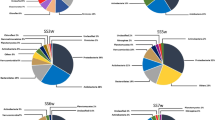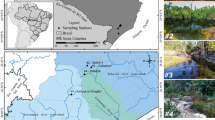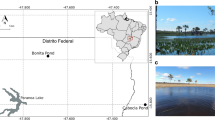Abstract
Mining negatively affects the environment by producing large quantities of metallic tailings, such as those contaminated with arsenic, with harmful consequences for human and aquatic life. A culture-independent molecular analysis was performed to assess the prokaryotic diversity and community structural changes of the tropical historically metal-contaminated Mina stream (MS) and the relatively pristine Mutuca stream (MTS) sediments. A total of 234 bacterial operational taxonomic units (OTUs) were affiliated with 14 (MS) and 17 (MTS) phyla and 53 OTUs were associated with two archaeal phyla. Although the bacterial community compositions of these sediments were markedly distinct, no significant difference in the diversity indices between the bacterial communities was observed. Additionally, the rarefaction and diversity indices indicated a higher bacterial diversity than archaeal diversity. Most of the OTUs were affiliated with the Proteobacteria and Bacteroidetes phyla. Alphaproteobacteria, Gemmatimonadetes and Actinobacteria were only found in the MS clone library. Crenarchaeal 16S rDNA sequences constituted 75 % of the MS archaeal clones, whereas Euryarchaeota were dominant in the MTS clones. Despite the markedly different characteristics of these streams, their bacterial communities harbor high diversity, suggesting that historically mining-impacted sediments promote diversity. The findings also provide basis for further investigation of members of Alphaproteobacteria as potential biological indicators of arsenic-rich sediments.


Similar content being viewed by others
References
Abreu C, Jurgens G, De Marco P, Saano A, Bordalo AA (2001) Crenarchaeota and Euryarchaeota in temperate estuarine sediment. J Appl Microbiol 90:713–718
Anderson CR, Cook GM (2004) Isolation and characterization of arsenate-reducing bacteria from arsenic-contaminated sites in New Zealand. Curr Microbiol 48:341–347
Banks D, Younger PL, Arnesen RT, Iversen ER, Banks SB (1997) Mine-water chemistry: the good, the bad and the ugly. Environ Geol 32:157–174
Borba RP, Figueiredo BR, Rawllins BG, Matchullat J (2000) Arsenic in water and sediment in the Iron Quadrangle, Minas Gerais state, Brasil. Revista Brasileira de Geociências 30:554–557
Borba RP, Figueiredo BR, Matchullat J (2003) Geochemical distribution of arsenic in waters, sediments and weathered gold mineralized rocks from Iron Quadrangle, Brazil. Environ Geol 4:39–52
Bouskill NJ, Barker-Finkel J, Galloway TS, Handy RD, Ford TE (2010) Temporal bacterial diversity associated with metal-contaminated river sediments. Ecotoxicol 19:317–328
Branco R, Francisco R, Chung AP, Morais PV (2009) Identification of an aox system that requires cytochrome c in the highly arsenic-resistant bacterium Ochrobactrum tritici SCII24. App Environ Microbiol 75:5141–5147
Canadian Environmental Quality Guidelines (1999) Protocol for the derivation of Canadian sediment quality guidelines for the protection of aquatic life. CCME. http://www.ccme.ca/publications/ceqg_rcqe.html?category_id=124. Accessed 30 November 2011
Canadian Environmental Quality Guidelines (2003) Summary of existing Canadian environmental quality guidelines. CCME. http://www.ccme.ca/publications/ceqg_rcqe.html?category_id=124. Accessed 30 Nov 2011
Cardinali-Rezende J, Debarry RB, Colturato LFDB, Carneiro EV, Chartone-Souza E, Nascimento AMA (2009) Molecular identification and dynamics of microbial communities in reactor treating organic household waste. Appl Microbiol Biotechnol 84:777–789
Chang JS, Yoon IH, Lee JH, Kim KR, An J, Kim KW (2010) Arsenic detoxification potential of aox genes in arsenite-oxidizing bacteria isolated from natural and constructed wetlands in the Republic of Korea. Environ Geochem Health 32:95–105
Chao A (1984) Non-parametric estimation of the number of classes in a population. Scand J Stat 11:265–270
Cheng H, Hu Y, Luo J, Xu B, Zhao J (2009) Geochemical process controlling fate and transport of arsenic in acid mine drainage (ADM) and natural systems. J Hazard Mater 165:13–26
Cidu R, Biddaw R, Fanfani L (2009) Impact of past mining activity on the quality of groundwater in SW Sardinia (Italy). J Geochem Explor 100:125–132
Collinet MN, Morin D (1990) Characterization of arsenopyrite oxidizing Thiobacillus. Tolerance to arsenite, arsenate, ferrous and ferric iron. Antonie Van Leeuwenhoek 57:237–244
DeLong EF (1992) Archaea in coastal marine environments. Proc Natl Acad Sci 89:5685–5689
Eisler R (2004) Arsenic hazard to humans, plants and animals from gold mining. Environ Contam Toxicol 180:133–165
Eleutério L (1997) Diagnóstico da situação ambiental da cabeceira da bacia do Rio Doce, no âmbito das contaminações por metais pesados em sedimentos de fundo. Dissertation, UFOP
Erwing B, Grenn P (1998) Base-calling of automated sequencer traces using phred II. Error probabilities. Genome Res 8:186–194
Escalante G, Campos VL, Valenzuela C, Yañez J, Zaror C, Mondaca MA (2009) Arsenic resistant bacteria isolated from arsenic contaminated river in the Atacama Desert (Chile). Bull Environ Contam Toxicol 83:657–661
Fisher E, Dawson AM, Polshyna G, Lisak J, Crable B, Perera E, Ranganathan M, Thangavelu M, Basu P, Stolz JF (2008) Transformation of inorganic and organic arsenic by Alkaliphilus oremlandii sp. nov. Strain OhILAs. Ann NY Acad Sci 1125:230–241
Freitas DB, Lima-Bittencourt CI, Reis MP, Costa PS, Assis PS, Chartone-Souza E, Nascimento AMA (2008) Molecular characterization of early colonizer bactéria from wastes in a steel plant. Lett Appl Microbiol 47:241–249
Galagan JE, Nusbaum C, Roy A, Endrizzi MG, MacDonald P, Fitzhugh W, Calvo S, Engels R et al (2002) The genome of M. Acetivorans reveals extensive metabolic and physiological diversity. Genome Res 12:532–542
Gillan DC, Danis B, Pernet P, Joly G, Dubois P (2005) Structure of sediment-associated microbial communities along a heavy-metal contamination gradient in the marine environment. Appl Environ Microbiol 72:679–690
Good IJ (1953) The population frequencies of species and the estimation of population parameters. Biometrika 40:237–262
Gordon D, Abajian C, Green P (1998) Consed: a graphical tool for sequence finishing. Genome Res 8:195–202
Green P (1994) PHRAP documentation. http://www.phrap.org. Accessed 28 Sept 2011
Gremion F, Chatzinotas A, Harms H (2003) Comparative 16S rDNA and 16S rRNA sequence analysis indicates that Actinobacteria might be a dominant part of the metabolically active bacteria in heavy metal-contaminated bulk and rhizosphere soil. Environ Microbiol 5:896–907
Hallberg KB (2010) New perspectives in acid mine drainage microbiology. Hidrol Met 104:448–453
Halter D, Cordi A, Gribaldo S et al. (2011) Taxonomic and functional prokaryote diversity in mildly arsenic-contaminated sediments. Res Microbiol 162:877–887
Harris JK, Kelley ST, Pace NR (2004) New perspective on uncultured bacterial phylogenetic division OP11. Appl Environ Microbiol 70:845–849
Heikkinen PM, Räisänen ML, Johnson RH (2009) Geochemical characterization of supage and drainage water quality from two sulphide mine tailings impoundments: acid mine drainage versus neutral mine drainage. Mine Water Environ 28:30–49
Holmström H, Öhlander B (1999) Oxygen penetration and subsequent reactions in flooded sulphidic mine tailings: a study at Sterenjokk, northern Sweden. Appl Geochem 14:747–759
Honschopp S, Brunken N, Nehrhorn A, Breunig HJ (1996) Isolation and characterization of a new arsenic methylating bacterium from soil. Microbiol Res 151:37–41
Horner-Devine MC, Carney KM, Bohannan BJM (2004) An ecological perspective on bacterial biodiversity. Proc R Soc Lond 271:113–122
Huang Y, Li H, Rensing C, Zhao K, Johnstone L, Wanga G (2012) Genome sequence of the facultative anaerobic arsenite-oxidizing and nitrate-reducing bacterium Acidovorax sp. strain NO1. J Bacteriol 194:1635–1636
Huber T, Faulkner G, Hugenholtz P (2004) Bellerophon: a program to detect chimeric sequences in multiple sequence alignments. Bioinforma 20:2317–2319
Hughes JB, Bohannan BJM (2004) Application of ecological diversity statistics in microbial ecology. In: Kowalchuk GA, de Bruijn FJ, Head IM, Akkermans AD, van Elsas JD (eds) Molecular microbial ecology manual, 2nd edn. Kluwer Academic, London, pp 1321–1344
Islam FS, Pederick RL, Gault AG, Adams LK, Polya DA, Charnock JM, Lloyd JR (2005) Interactions between the Fe(III)-reducing bacterium Geobacter sulfurreducens and arsenate, and capture of the metalloid by biogenic Fe(II). App Environ Microbiol 71:8642–8648
Johnson DB, Hallberg KB (2005) Acid mine drainage remediation options: a review. Sci Total Environ 338:3–14
Katsoyiannis IA, Zouboulis AI (2004) Application of biological processes for the removal of arsenic from groundwaters. Water Res 38:17–26
Koroleff F (1976) Determination of nutrients. In: Grasshoff K (ed) Methods of seawater analysis, 1st edn. Verl Chemie Weinhein, New York, pp 117–181
Laforte L, Tessier H, Gobeil C, Carignan R (2005) Thalium diagensis in lacustrine sediments. Geochem Cosmochem Acta 69:5295–5306
Lane DJ (1991) 16S/23S rDNA sequencing. In: Stackebrandt E, Goodfellow M (eds) Nucleic acid techniques in bacterial systematics. Wiley, New York, pp 115–148
Lièvremont D, Bertin PN, Lett MC (2009) Arsenic in contaminated waters: biogeochemical cycle, microbial metabolism and biotreatment processes. Biochimie 91:1229–1237
Lindsay MBJ, Condon PD, Jambor JL, Lear KG, Blowes DW, Ptacek CJ (2009) Mineralogical, geochemical and microbial investigation of a sulfide- rich tailing deposit characterized by neutral drainage. Appl Geochem 24:2221–9212
Mackereth JFH, Heron J, Talling JF (1978) Water analysis: some revised methods for limnologists. Freshw Biol Assoc 36:117–121
Meuer J, Kuettner HC, Zhang JK, Hedderich R, Metcalf WW (2002) Genetic analysis of the Archaeon Methanosarcina barkeri FUSARO reveals a central role for Ech hydrogenase and ferredoxin in methanogenesis and carbon fixation. Proc Natl Acad Sci 99:5632–5637
Mohapatra BR, Gould WD, Dinardo O, Karen DW (2011) Tracking the prokaryotic diversity in acid mine drainage- contaminated environments: a review of molecular methods. Miner Eng 24:709–718
Mortatti J, Hissler C, Probst J-L (2010) Distribuição de Metais Pesados nos sedimentos de fundo ao longo da Bacia do Rio Tietê. Geol USP 10:3–11
Muyzer G, De Waal EC, Uitterlinden AG (1993) Profiling of complex microbial populations by denaturing gradient gel electrophoresis analysis of polymerase chain reaction-amplified genes coding for 16S rRNA. Appl Environ Microbiol 59:695–700
Nicomrat D, Dick WA, Dapson M, Tuovinen OH (2008) Bacterial phylogenetic diversity in a constructed wetland system treating acid coal mine drainage. Soil Biol Biochem 40:312–321
Nriagu JO (2002) Environmental chemistry of Arsenic. Dekker, New York, pp 1–26
Ochsenreiter T, Selezi D, Quaiser A, Bonch-Osmolovskaya L, Schleper C (2003) Diversity and abundance of Crenarchaeota in terrestrial habitats studied by 16S rRNA surveys and real time PCR. Environ Microbiol 5:787–797
Pettitt AN (1982) Cramer-von Mises statistic. In: Kotz S, Johnson NL (eds) Encyclopedia of statistical sciences. Wiley Interscience, New York, pp 220–221
Raskin L, Stromley JM, Rittmmann BE, Stahl DA (1994) Group-specific 16S rRNA hybridization probes to describe natural communities of methanogens. Appl Environ Microbiol 60:1232–1240
Rastogi G, Stetler LD, Peyton BM, Sani RK (2009) Molecular analysis of prokaryotic diversity in the deep subsurface of the former Homestake gold mine, South Dakota, USA. J Microbiol 47:371–384
Röske K, Sachse R, Scheerer C, Röske I (2011) Microbial diversity and composition of the sediment in the drinking water reservoir Saidenbach (Saxonia, Germany). Syst Appl Microbiol 35:35–44
Schloss PD, Handelsman J (2005) Introducing DOTUR, a computer program for defining operational taxonomic units and estimating species richness. Appl Environ Microbiol 71:1501–1506
Singleton DR, Furlong MA, Rathbun SL, Whitman WB (2001) Quantitative comparisons of 16S rDNA sequence libraries from environmental samples. Appl Environ Microbiol 67:4373–4376
Smedley PL, Kinniburgh DG (2002) A review of the source, behavior and distribution of arsenic in natural waters. Appl Geochem 17:517–568
Sorci J, Paulauskis JD, Ford T (1999) 16S rRNA restriction fragment length polymorphism analysis of bacterial diversity as a biomarker of ecological health in polluted sediments from New Bedford Harbor, Massachusetts, USA. Mar Pollut Bull 38:663–675
Staroscik A (2004) Calculator for determining the number of copies of a template. http://www.uri.edu/research/gsc/resources/cndna.html. Accessed 25 July 2011
Takai K, Moser DP, DeFlaun M, Onstott TC, Fredrickson JK (2001) Archaeal diversity in waters from deep South African gold mines. Appl Environ Microbiol 67:5750–5760
Tamaki H, Tanaka Y, Matsuzawa H, Muramatsu M, Meng X, Hanada S, Mori K, Kamagata Y (2011) Armatimonas rosea gen. nov., sp. nov., of a novel bacterium phylum, Armatimonadetes phyl. nov., formally called the candidate phylum OP10. Int J Syst Evol Microbiol 61:1442–1447
Thomas JE, Smart RSC, Skinner WM (2000) Kinetic factors for oxidative and non-oxidative dissolution of iron sulfides. Min Eng 13:1149–1159
Tsuchiya C, Sakata T, Sugita H (2008) Novel ecological niche of Cetobacterium somerae, na anaerobic bacterium in the intestinal tracts of freshwater fish. Lett Appl Microbiol 46:43–48
Varejão EVV, Bellato CR, Fontes MPF, Mello JWV (2011) Arsenic and trace metals in river water and sediments from the southeast portion of the Iron Quadrangle, Brazil. Environ Monit Assess 172:631–642
Vial DS, Duarte BP, Fuzikawa K, Vieira MBH (2007) An epigenetic origin of the Passagem de Mariana gold deposit, Quadrilatero Ferrífero, Minas Gerais, Brazil. Ore Geol Rev 32:596–613
Whiticar MJ (1999) Carbon and hydrogen isotope systematic of bacterial formation and oxidation of methane. Chem Geol 161:291–314
Williams M (2001) Arsenic in mine waters: international study. Environ Geol 40:267–278
Younger PL (2002) Mine Water Pollution from Kernow to Kwazulu-Natal: geochemical remedial options and their selection in pratice. Geosci South-West Engl 10:255–266
Zhender AJB, Ingvorsen K, Marti T (1982) Microbiology of methane bacteria. In: Hughes et al (eds) Anaerobic digestion. Elsevier Biomedical Press, Amsterdam, pp 45–68
Zhou J, Kia B, Treves DS, Wu L-Y, Marsh TL, O’Neill RV, Palumbo AV, Tiedje JM (2002) Spatial and resource factors influencing high microbial diversity in soil. Appl Environ Microbiol 68:326–334
Acknowledgments
This work was supported by the Fundação de Amparo à Pesquisa do Estado de Minas Gerais (FAPEMIG), the Conselho Nacional de Desenvolvimento Científico e Tecnológico (CNPq), the Pró-Reitoria de Pesquisa da UFMG (PRPq) and the Coordenação de Aperfeiçoamento de Pessoal de Nível Superior (CAPES) in the form of a scholarship to Mariana P. Reis. We appreciate the support technical from Laboratório de Análises Químicas/DEMET/UFMG do Instituto Nacional de Ciência e Tecnologia em Recursos Minerais, Água e Biodiversidade—INCT—ACQUA in the chemical analyses and Thais Amaral for cartographic support. A.M.A.N. is a recipient of CNPq fellowships.
Author information
Authors and Affiliations
Corresponding author
Additional information
Communicated by M. da Costa.
Electronic supplementary material
Below is the link to the electronic supplementary material.
Rights and permissions
About this article
Cite this article
Reis, M.P., Barbosa, F.A.R., Chartone-Souza, E. et al. The prokaryotic community of a historically mining-impacted tropical stream sediment is as diverse as that from a pristine stream sediment. Extremophiles 17, 301–309 (2013). https://doi.org/10.1007/s00792-013-0517-9
Received:
Accepted:
Published:
Issue Date:
DOI: https://doi.org/10.1007/s00792-013-0517-9




